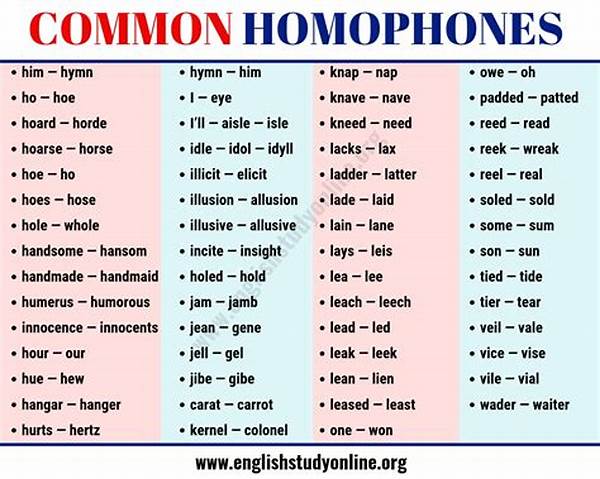Learning a new language is an exciting journey, yet it’s often sprinkled with challenging moments. One hiccup many learners face is the mix-up of words that sound the same but have different meanings. These tricky pairs are known as homophones. As beginners dive into learning English, misused homophones can lead to some amusing, and occasionally confusing, situations. Understanding these common mix-ups is a key step toward mastering the language and avoiding misunderstandings.
Understanding the Common Mix-Ups
For those at the start of their English-learning journey, misused homophones by beginners can be a common hurdle. Words like “their,” “there,” and “they’re” or “to,” “two,” and “too” often trip up new learners. It’s easy to see why: they sound identical when spoken but carry entirely different meanings and uses. Beginners might write “bear” when they mean “bare” or confuse “right” with “write.” These mix-ups can change the meaning of sentences entirely, leading to confusion in both written and spoken communication. By recognizing these common errors, beginners can develop a clearer understanding of context and correct usage, improving their overall proficiency in the language.
How to Correctly Use Homophones
1. Their vs. There vs. They’re: Misused homophones by beginners often include this trio. “Their” is possessive, “there” refers to a place, and “they’re” is a contraction for “they are.”
2. To vs. Too vs. Two: “To” is a preposition, “too” means also or overly, and “two” represents the number. These are frequently misused homophones by beginners.
3. Your vs. You’re: Beginners often mix up “your,” showing possession, and “you’re,” short for “you are.” Understanding the context is key.
4. Its vs. It’s: Misused homophones by beginners commonly include “its,” denoting possession, and “it’s,” a contraction for “it is.”
5. Brake vs. Break: “Brake” refers to stopping a vehicle, while “break” means to separate into pieces. These can be easily confused by beginners.
Overcoming Mistakes with Practice
The struggles with misused homophones by beginners aren’t insurmountable. The key is awareness and practice. Language learners can benefit greatly from context-based examples that illustrate the differences between these tricky words. Engaging in daily reading and writing exercises can help reinforce correct usage. Translation apps and language courses also offer exercises focusing on homophones, enabling learners to practice in a guided environment. By incorporating these strategies into their learning routine, beginners can gradually build their confidence and accuracy in using homophones correctly.
Beyond structured exercises, real-world practice is invaluable. Conversations with native speakers offer practical experience, helping learners see how homophones are used in everyday situations. This exposure not only aids in recognizing misused homophones by beginners but also enriches overall language comprehension. With time and sustained effort, the initial confusion fades, paving the way to clearer and more effective communication.
Common Examples and Their Impact
Misused homophones by beginners can result in sentences that are either amusing or bewildering. Consider “She went to the store for flour,” versus “floor.” The former suggests a baking ingredient; the latter, an unusual shopping trip indeed! Another frequent switch is between “seas” and “seize”; one involves oceans, the other, actions. These examples highlight how a single word can tilt the meaning of an entire sentence. By becoming familiar with such pairings, learners can avoid misinterpretations and the potential embarrassment they entail in everyday conversation.
Additionally, written communication—be it emails, texts, or essays—is where misused homophones by beginners often stand out. A simple confusion, like using “principal” instead of “principle,” might slip by unnoticed in spoken exchanges but could alter the intended message significantly in writing. As beginners develop their skills, paying attention to these nuances can enhance their written communication and make a positive impression.
Strategies for Mastery
Mistakes with misused homophones by beginners can be reduced with deliberate practice. First, try associating words with pictures or situations to enhance memory retention. Another effective method is memorizing each word’s definition and context through flashcards. Engaging with a partner can also foster progression, as partners can point out mistakes and suggest improvements. Moreover, digital resources like grammar-checking tools offer real-time feedback, allowing learners to identify errors instantly and understand their corrections.
Regular practice is crucial, but maintaining a curious and open attitude toward learning is just as important. Staying inquisitive and seeking clarity when stumbling upon unfamiliar words can spur growth. As learners employ these strategies, they gain more than just proficiency in distinguishing homophones; they sharpen an overall understanding of the English language and become more confident communicators.
Conclusion
To sum up the issue of misused homophones by beginners, consistent practice and exposure to various learning materials are vital. Through exercises, real-world interactions, and an openness to learning, beginners can gradually master the nuances of homophones. This proficiency will not only enhance their command of English but also empower them to communicate their thoughts with clarity and precision. Aspiring language learners—embrace these tools and strategies to navigate the exciting, complex world of homophones with ease.
